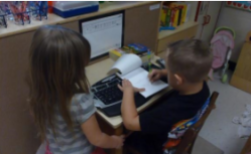UPDATED POST with Link to Pieces for a Linear Calendar
Our youngest learners are concrete thinkers; they live in the now. They are not ready for abstract thought. So, let’s ponder the effectiveness of a traditional calendar time that focuses on days of the week, months of the year, patterns, counting, etc. It is not until children are around the ages of 7 to 10 years of age that they are able to judge the relative time from a past event or until a future event will occur. Teaching the skills of time such as yesterday, today and tomorrow, days of the week and months of the year is not developmentally appropriate and can inhibit a child’s confidence in their skills. They may eventually stop participating and/or lose their confidence in their ability to achieve at school.
 There is little evidence that calendar activities that mark extended periods of time (week, month) are meaningful for children below first grade (Friedman, 2000). National Education Association for Young Children learn best through hands-on learning experiences and that developmentally appropriate practices include “teachers who “mathematize” children’s everyday experiences. For example, they help children learn and practice math skills and concepts during block building, play with games and manipulatives, and movement activities” (Developmentally Appropriate Practice Third Edition). Children will learn patterns, counting, number relationships, etc. best through individual and small group hands-on, meaningful activities, not through the repetitive calendar activities which do not hold any meaning for them. (see https://journeyintoearlychildhood.com/2018/09/05/math-during-free-choice-play/ for pictures of incorporating math into free choice play centers)
There is little evidence that calendar activities that mark extended periods of time (week, month) are meaningful for children below first grade (Friedman, 2000). National Education Association for Young Children learn best through hands-on learning experiences and that developmentally appropriate practices include “teachers who “mathematize” children’s everyday experiences. For example, they help children learn and practice math skills and concepts during block building, play with games and manipulatives, and movement activities” (Developmentally Appropriate Practice Third Edition). Children will learn patterns, counting, number relationships, etc. best through individual and small group hands-on, meaningful activities, not through the repetitive calendar activities which do not hold any meaning for them. (see https://journeyintoearlychildhood.com/2018/09/05/math-during-free-choice-play/ for pictures of incorporating math into free choice play centers)
If teachers still want to incorporate some type of short calendar routine into their whole group time, here are some more developmentally appropriate ideas:
- Build concepts of later, before and after by reviewing the daily schedule.

- Hold calendar time at the end of the day and include a student job of drawing a picture of one exciting event that occurred during the day such as we read The Hungry Caterpillar, we found a caterpillar on the playground, we built a big car, etc.
 Use a linear calendar (7 days). For very young children, the linear calendar should be vertical, just like the daily schedule, and as they grow in their developmental skills, it can be horizontal. Use pictures of home and school- discuss if it is a home day or a school day. Count how many days we have been at school OR chart the weather and discuss how many rainy, sunny, etc. days. LINEAR CALENDAR PIECES FOR HOME/SCHOOL and WEATHER
Use a linear calendar (7 days). For very young children, the linear calendar should be vertical, just like the daily schedule, and as they grow in their developmental skills, it can be horizontal. Use pictures of home and school- discuss if it is a home day or a school day. Count how many days we have been at school OR chart the weather and discuss how many rainy, sunny, etc. days. LINEAR CALENDAR PIECES FOR HOME/SCHOOL and WEATHER- Start to build the concept of week and month by documenting the work that is
 accomplished in the classroom. At the end of each week and/or each month, have the students choose 3-5 pictures from a group of pictures that you have taken over that period of time. They need to reflect on the learning they have done that week and decide as a group which pictures best represent that learning. Jot down children’s comments on notecards. Place the pictures with the comments in a scrapbook or on a large piece of paper to hang in the hallway or classroom. This is a great way to document and showcase children’s learning as well as to demonstrate growth over time.
accomplished in the classroom. At the end of each week and/or each month, have the students choose 3-5 pictures from a group of pictures that you have taken over that period of time. They need to reflect on the learning they have done that week and decide as a group which pictures best represent that learning. Jot down children’s comments on notecards. Place the pictures with the comments in a scrapbook or on a large piece of paper to hang in the hallway or classroom. This is a great way to document and showcase children’s learning as well as to demonstrate growth over time.
Resources:
Beneke, Sally J., Ostrosky, Michailene, and Katz, Lilian G. May 2008. Calendar Time for Young Children: Good Intentions Gone Awry. Young Children.
Coople, Carol and Bredekamp, Sue, editors. Developmentally Appropriate Practice in Early Childhood Programs. Third Edition. National Association for the Education of Young Children.
Friedman, W.J. 2000. The development of children’s knowledge of the times of future events. Child Development 71.











